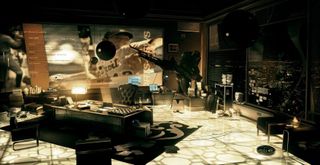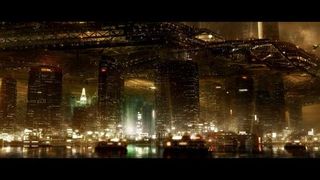Interview: the art of Deus Ex: Human Revolution

If you've been following our Deus Ex week stuff, you'd probably recognise Jonathan Jacques-Belletete if you saw him. Because he's not just the game's Art Director, responsible for its odd blend of Renaissance fashions and cyberpunk tech, he's also the model the player character Adam Jensen is based on. I asked him about the difficulties of making art for an open-ended game, whether Human Revolution is too futuristic for its own good, and the neglected status of cyberpunk.
PCG: I was joking with the guys that my first question should be: “Why is the main character so ugly?”
Jonathan Jacques-Belletete: Yeah, cause he's fucking ugly! Come on!
PCG: But yeah, I gather you were looking around for a face to base the character on and you had modelling experience, so-
Jacques-Belletete: That's not really- I wish that that's what happened-
PCG: That's what I was told.
Jacques-Belletete: Really? Who told you that, Andre?
The biggest gaming news, reviews and hardware deals
Keep up to date with the most important stories and the best deals, as picked by the PC Gamer team.
PCG: Uh, yeah.
Jacques-Belletete: Freakin' Andre. The way that it really happened, honestly – it's funny because it's pretty obvious that it looks like me, but you guys are really the first bunch where everybody's asking me this question. Usually people don't ask, even though it's super obvious. It's never really been wanted that way, like, “Let's put Jon in the game”, not at all. It started with the poster. Jim, this awesome illustrator that we have, like a crazy genius artist, he had to do that. He had a really short period of time and he wanted someone to pose for it just to get the pose down, which kind of speeds up the process. So I posed for that, and then, being the crazy illustrator that he is, he's just so talented, that this ended up really being me and everything.
And also, we've never wanted to have a big brutish dude in a game, you know like a Marcus Fenix type of guy. A sentence that we always say is that “Adam can seriously kick your ass, but he goes home and reads a good book.” Then we wanted the Don Quixote thing with the little goatee and stuff. But yeah, definitely he totally looks like me. It's like a coincidence and it isn't. It's a coincidence because it's never been something that we wanted to do, and then it isn't a coincidence because Jim said “You wanna pose?” and I said “Sure.”

PCG: You talk a lot about the amount of detail that goes into the game's environments; it seems to me like one of the principles of Deus Ex is being able to choose your own path, and the natural consequence of that is that you don't get to see everything in the game. Isn't it kind of counter-intuitive to have a method that involves a lot of work for every square inch of space, and then a game that demands a lot of space in order to allow the player to have freedom?
Jacques-Belletete: The thing is that none of that was done at a compromise of the amount of areas you can explore or how expansive the game is really. What became a challenge, though, within all that amount of detail, was to make sure that we still had proper visual tools to kind of guide the player within all those different paths and everything. Now obviously some paths are really really hidden, we don't want to have like an arrow that points you to that direction, but we needed to come up with a lot of good ideas to make sure that the player can decode the image properly.
But apart from that the fact that the game has a lot of sections for you to either find or see or not see or whatever, and the fact that they're all really detailed and cluttered and stuff I don't think really affects one another. Also just thematically some placers are a lot slicker and cleaner just by design, by what they are.

PCG: In the presentation earlier, you went into quite a lot of depth about how the really futuristic looking stuff in the game isn't all that far-off present day. Obviously it's nice for us as journalists to know that, but players coming to the game fresh won't know it. Is there a risk that people are going to feel- not put off by it, but a little less engaged by a world that's so seemingly far from our own?
I think that obviously it's about how we balance it in the game. The portion that you just saw [featuring a double-decker city outside Shanghai] definitely has probably our most crazy advanced thing in the game, it's kind of like our Death Star. It's like, you watch Star Wars and there's all these cool things and suddenly there's this ball of metal that floats, and it's like, “What the hell”, you know? But you've been through so many mundane and contemporary places, in between and before and after and stuff like that. I think it counterbalances pretty well.
When you're in Detroit I think you really feel properly like the Detroit of today, with real technological stuff just added over. For example, there's stuff like the charging stations for electrical cars, and again you see all the logos on there, and you can read the instructions on how the whole thing would function and stuff like that. You look at the car designs and they're inspired by concept cars that are being done today.
For example, in the demo, when you're in the seaport, the immediate playing area is really like a seaport. It looks fairly, you know, like the thing could be fifty, sixty years old, but then you look, you tilt your head and there's that double decker city thing there. So I think it's this juxtaposition that we're doing all the time, I think it makes it work. I think that's what the anticipation is and I think that's also what Cyberpunk is. It's like, the old is there, but there's that crazy new that's grafted over it. And we have it at different levels, you know, the double decker is right there, but there's like all these little things left and right.
Most Popular

